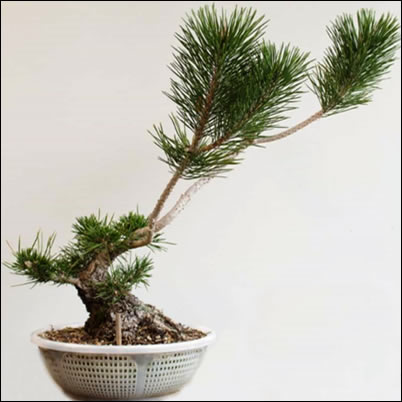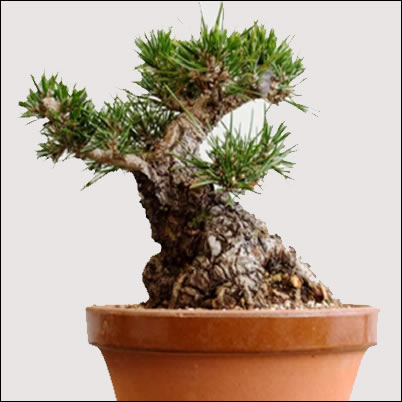Pruning and Trimming for Refinement
Scissor Trimming
Trimming deciduous trees with scissors is straightforward; take care and do not rush. Scissors should be used to cut stems and not leaves. If you cut leaves or needles the ends or edges will go brown; it is unsightly but not harmful. Any kind of leaf that is cut will quickly brown off and look untidy. For training trees it does not matter but for show trees, brown edges are not acceptable. Each shoot that you are cutting back should be held by its top and cut through the stem immediately above an internode .
Finger-Pruning
Mostly done for the foliage of Junipers, Cedars, Larch and Cryptomeria, and carried out regularly. This is throughout the season as new elongated shoots appear. Coniferous species have foliage which contains a 'weak point' that, if utilized, can enable removal of the shoot/needle without browning off. By holding the tip of the shoot between the pads of the finger and thumb and gently pulling away, the weak point of the shoot breaks cleanly and the shoot can be pulled away. Care must be taken not to use fingernails to apply more pressure; this will cause the foliage shoot to break at a point where browning off can occur.
This regular pruning will result in denser foliage emerging leading to the eventual creation of foliage pads.
Trimming Twigs, Small Branches and De-budding
This is important to refine the branch structure and can be applied to both deciduous and coniferous with minor variations according to genus.
The correct place to cut, directly behind an upward facing bud, this means the new shoot grows down enabling you to wire into position.

A new shoot will appear from the next bud, wire into position and trim beyond the first outside bud. If you trim off at the wrong bud the shoot will grow straight up and be impossible to correct

Creating a Taper
Can a deciduous branchthis branch be improved over the forthcoming years?
If this branch is pruned back repeatedly to keep it in shape it will slowly increase the ramification (number of tertiary branches) to an impressive number. The density of the foliage will increase and leaf-size will be reduced, both of which will create a good impression of age. However, the taper of the end branches will be slowly lost and the taper between the branch base and the branch be rejuvenated?

Simply by pruning it back very hard and rebuilding it. Bonsai are said to be never finished and this is a good example of what this statement actually means.
Bonsai is a unique art form in that unlike other pieces of art, a tree is forever changing, Removing the ramification of the branch can feel very much like a step backwards in the development of the tree; long-term it is a large leap forward.
You can heavily prune the branch back to its basic shape and then wire and reshaped as necessary. Within 2 years, months of rebuilding the branch ramification will have built up and when compared to its appearance after 5 years development, the illusion of age is very apparent. The process of rebuilding the tree can, in theory, be repeated over and over again for the duration of the life of the tree. This is likely to be a very long time leading to incredible taper and a magnificent illusion of age!


Thickening trunks by allowing branch extensions
Vertical cuts do not make the trunk thicken; they just produce vertical scars. People have advocated punching the trunk with knife tips, but that is just a way to make your tree vulnerable to a fungal infection. It has also been suggested that one literally hammer their trunks - the problem is that it is impossible to avoid damaging the cambium layer in some places so why risk it?
A trunk/branch thickens more rapidly the more foliage it carries. It also thickens faster if the extension growth is allowed to run. Cutting a branch will slow the rate of its thickening, but with many species the increased leaf area that comes as a result of ramification can more than compensate for the setback. This process, though, produces a stem with little taper. Therefore, you eventually must prune off most of it and start the process anew with another ‘sacrifice’ in order to make a tapered trunk.
On conifers great care must be taken to keep small lower branches alive – once they are gone, they are gone because there is little chance of regenerating them
It is easier to control the growth in containers, but trunk thicknesses are limited to 2or 3 inches. Allowing a sacrificial branch to grow on will cause the base to thicken or flare. Grow on until you have the required thickness in the trunk and then cut off the sacrificial branch and seal with cut paste .

Web design: nysys
